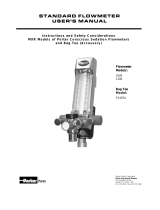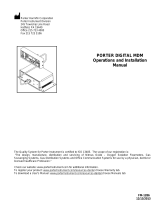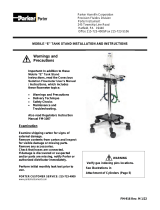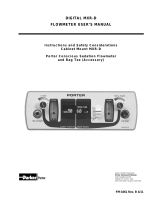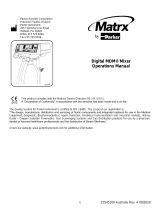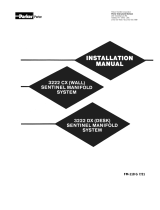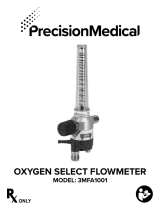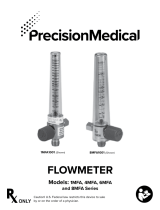Page is loading ...

U S E R I N S T R U C T I O N S
F O R
A S S E M B L Y
I N S T A L L A T I O N
A N D
C L E A N I N G
P O R T E R S c a v e n g e r R u b b e r G o o d s S y s t e m
A v a i l a b l e w i t h A u t o m a t i c V a c u u m S w i t c h ( A V S )
A v a i l a b l e w i t h V a c u u m C o n t r o l B l o c k
N O T I C E
R E A D M A N U A L C O M P L E T E LY
B E F O R E O P E R A T I N G T H I S D E V I C E
The Quality System for Porter Instrument is Certified to ISO 13485. The scope of our registration is: “The
design, manufacture, distribution and servicing of Dental Flowmeters, Gas Scavenging Systems, Gas
Distribution Systems and Office Communication Systems for use in the Dental Profession.”

1
User Instructions
The Porter System is designed to solve the
problem of exposure to Nitrous Oxide.
Comfortable and quiet, the unique design of the
mask minimizes any “competition” between the
vacuum source and the patient. It allows the
patient to receive the proper amount of Oxygen
and Nitrous Oxide with normal respiratory effort.
The silicon tubing and mask have increased
durability and are steam and chemical vapor
autoclavable.
Porter features a mask-within-a-mask
scavenging system. Metal and plastic parts
have been eliminated from the mask so that x-
rays can be taken during a procedure without
removing the mask. The mask includes easy-to-
remove inner liners that simplify cleaning and
sterilization. The soft inner mask provides an
excellent seal around the nose and a
comfortable fit for the patient. Also available, are
single-use personal mask liners for the Porter
Scavenging System.
A Non-Rebreathing Valve (NRV) and Emergency
Air Intake (EAI) located on the bag tee provide
safety features and make the “breathing bag” the
visual barometer for monitoring the patient’s
respiration rate. (See NRV and EAI tests
below.)
Porter Retrofit Kits
Porter Scavenger Retrofit Kits are available for
most brands of flowmeters. You can upate your
present nitrous oxide system for improved
safety, durability, and comfort. These kits
provide the standard features of Non-
Rebreathing Valves (NRV) and Emergency Air
Intakes (EAI) - important safeguards your
present system may not have. You can easily
check your current system for these safeguards
using the following tests:
Non-Rebreathing Valve (NRV) Test
Disassemble the fresh gas tubing from the mask
and “Y” connector, and breathe back into the
fresh gas corrugated tubing (Figure 1, Item 9)
connected to the flowmeter. You should not be
able to fill the reservoir bag with exhaled gas. If
the bag fills, this breathing circuit has no NRV
and would allow for carbon dioxide (CO2) buildup
in the breathing bag.
Emergency Air Intake (EAI) Test
With the flowmeter turned off and the breathing
bag empty, inhale through the mask. A check
valve assembly should open allowing “room air”
into the breathing circuit. If no room air enters
the breathing circuit, this circuit has no EAI - an
essential component for the safe and effective
administration of Nitrous Oxide and Oxygen.
If your system fails either of these tests, your
system should be updated with a Porter
Scavenger Retrofit Kit.
IMPORTANT: It is not recommended to
retrofit Porter Scavenger Rubber Goods to A-
dec or Veriflo Flowmeters. It is only
recommended to retrofit an AVS to the Porter
Scavenger Systems and Porter Flowmeters,
with the exception of the Porter Oral Surgeon
unit (Model 3000-OS).
ASSEMBLY INSTRUCTIONS
1. Bag Tee to Flowmeter:
Screw knurled seal nut down tight onto
Flowmeter making sure the rubber washer
is inside the seal nut. When tight, Bag Tee
should not rotate.
2. AVS 5000 / Bag Tee to Flowmeter:
Screw AVS 5000 knurled seal nut down
tight onto flowmeter making sure the rubber
washer is inside seal nut. When tight, AVS
should not rotate. Then, screw Bag Tee
seal nut onto AVS. Bag Tee should not
rotate.

2
3. Rubber Goods to Bag Tee: (Refer to item (#) in parts list on the next page and Figures 1 and 2
on pages 4 and 5 for assembly and hook-up options.)
A. Attach the nasal inhaler (#3 or #4) to the coaxial tubing assembly (#5) using the diameter indexed
connectors (#11).
B. Attach one end of the fresh gas corrugated tubing (#9) to the coaxial tubing assembly (#5) at the
fresh gas “Y” connector (#7) and the other end to the 22-mm right angle flowmeter adapter (#10).
Press fit the 22-mm right angle flowmeter adapter (#10) onto the bag tee (#6).
C. Attach the 3 L bag (#13) to the bottom of the bag tee (#6).
D. Attach Vacuum Hoses (#8): Refer to Figure 1 page 4.
1. Automatic Vacuum Switch: Attach one end of the vacuum hose (#8) to the vacuum hose “Y”
connector (#12) and the other end to the MASK port (labeled on body) of the AVS (#1). Attach
a second vacuum hose (#8) to the VAC port (labeled on body) of the AVS (#1), then insert
straight end of adapter (#17) into the other end of the vacuum hose and the tapered end of
the adapter into the High Volume Evacuation (HVE) Line.
2. Vacuum Control Block: Attach one end of the vacuum hose (#8) to the vacuum hose “Y”
connector (#12) and the other end to the vacuum control block (#2).
The vacuum control block can then be inserted directly into the High Volume Evacuation
(HVE) Line; or may be placed “in line” by cutting the vacuum hose and attaching the cut ends
of the tubing to both ends of the vacuum control block. NOTE: To properly read vacuum
levels, the vacuum control block must be held upright with the on / off switch above the control
valve. See Figure “A” below.
Figure A
Note: An adapter (#14 or #15, refer to Figure 2 page 5) is provided if the installer wishes to “tee”
into the vacuum line. The “tee” should be located after the solids collector.

3
ITEM
PART NUMBER.
/ REF
DESCRIPTION
(Refer to Figure 1 for Assembly & Figure 2 for Options for Vacuum Hook-up.)
1
AVS 5000
Automatic Vacuum Switch (AVS)
2
5501-RK
Vacuum Control Block Kit (Optional)
3
5054A
Porter Adult Nasal Inhaler Complete with 3 liners.
3a
5054-1
Package of 3 Adult Inner Liners
4
5054B
Porter Pedo Nasal Inhaler Complete with 3 liners.
4a
5054-2
Package of 3 Pedo Inner Liners
5
5056
Coaxial Tubing Assembly (Set of 2)
6
P1407A (US)
Bag Tee (REF P1407E for European)
7
5058
Fresh Gas “Y” Connector
8
5059
Vacuum Hose (8 ft.)
9
5060-3
Fresh Gas Corrugated Tubing, Non-Latex (3 ft.)
9a
5060-6
Fresh Gas Corrugated Tubing, Non-Latex (6 ft.) (Optional)
9b
4200
Fresh Gas Corrugated Tubing, Latex (2 ½ ft.) (Optional)
10
1571-22
22mm Right Angle Flowmeter Adapter
10a
1570-24
24mm Right Angle Flowmeter Adapter (Optional)
11
5061
Mask to Tubing Plastic Connectors (Set of 2)
12
5062
Vacuum Hose “Y” Connector
13a
4100-3NL
3 Liter Bag, Non-Latex
13b
4100-2NL
2 Liter Bag, Non-Latex
14
5063
1/2” ‘T’ Adapter for In-line Vacuum Block (See Figure 2)
14a
5068
5/8” ‘T’ Adapter for In-line Vacuum Block (See Figure 2)
15
5064
“Straight” Adapter for In-line Vacuum Block (See Figure 2)
16
5065
Vacuum Tube Holder
17
A-3679-000
Adapter, Black, ¾” Round (VAC/MASK)
Quick Test to Check 3 Liter Bag / Rubber
Goods for Leaks
1. With the flowmeter, bag tee and Porter
rubber goods in place, remove the
nosepiece and one of the two plastic
connectors from the Porter rubber goods.
Refer to Figure B.
2. With the other plastic connector, join the
two duplex hoses together making a
closed system.
3. Taking care not to fill the bag too much
(bag could burst), open the oxygen control
valve until the 3 liter bag starts to over-
inflate or “balloon”, then turn the meter off
at the ON / OFF switch.
4. Observe the 3 liter bag for five minutes.
5. The bag should stay inflated. If so, the
test has been successful and there are no
excessive leaks.
6. If the bag does not stay inflated, the 3-liter
bag or rubber goods have an excessive
that leak. Replace any parts that leak and
retest until results are successful.
7. Disconnect one of the duplex hoses from
the plastic connector and re-install the
nosepiece. Figure B
.
Remove one
connector
and join
hoses
together.

4

5

6
CAUTION
The vacuum system should be equipped with a
back flow shutoff device to prevent carryover of
fluids into equipment attached to the piping
systems. It is recommended that a separate
vacuum trap be used between the piping system
and the vacuum station inlet or any equipment
that is attached to the system.
CAUTION
DO NOT PROCESS ANY LIQUIDS OR DEBRIS
THROUGH THE AVS. This contamination can
cause damage and affect the function of the unit.
The AVS is designed to regulate the vacuum flow
level for scavenging of Nitrous Oxide / Oxygen
gas only.
Basic Operation:
For the AVS or Vacuum Control Block (Note:
Use either an AVS or a Vacuum Control
Block, not both):
1. AVS will automatically open upon the
delivery of 1.5 to 3.5 L/min of gas flow. The
Vacuum Control Block is manually operated
and must be opened by pushing “on/off”
toggle to “on” position.
2. Adjust vacuum flow by using vacuum control
knob and acrylic sight glass on side of AVS
or Vacuum Control block. Vacuum flow with
ball float within the green bar area is
effective; ball above green bar is for highest
vacuum flows.
3. Monitor the vacuum conditions during the
procedure by observing the sight glass;
adjust vacuum flow at any time as
necessary.
4. Follow good work practices as
recommended by NIOSH.
4.1. Caution the patient not to talk
unnecessarily or breathe through the
mouth.
4.2. The mask must be fitted properly to
avoid leaks. (Pedo mask for children.)
4.3. 100% Oxygen only should be
administered while the mask is being
placed. Flowing Nitrous Oxide while
fitting the mask will significantly
increase N2O ppm (parts per million)
exposures.
4.4. All Porter masks are sealed (no hole in
the front of the mask). An open air
valve or air dilution technique is not
recommended.
4.5. Flow only the volume of gas required by
the patient. An over-full reservoir bag
indicates excessive gas flow, which
could increase N2O ppm exposures.
4.6. 100% Oxygen only should be
administered for several minutes at the
end of the procedure. This will flush the
Nitrous Oxide from the patient. Failure
to follow this procedure will result in
higher N2O ppm exposure in the
operatory.
Field Performance Check of Adjustment of
Vacuum Flow Using the AVS:
1. Set a high flow: After assembly of AVS and
Scavenging System to the Flowmeter, set
flowmeter to flow 8 L/min of 100% Oxygen to
fully open AVS vacuum interlock.
2. Set vacuum level (green bar or higher):
Turn vacuum control knob to set vacuum
flow, as indicated by the vacuum indicator, in
the desired area *.
*Porter recommends that effective
scavenging can be achieved with the ball
float in the green bar area of the acrylic sight
glass, however NIOSH publications
conclude that higher vacuum flows of up to
45 L/min are most effective. To meet the
NIOSH recommendation of 45 L/min, adjust
the ball above the green bar area.
3. Close the flowmeter flow to zero. The ball
float will drop to the bottom of the sight
glass.
4. Check at low flow: Open the flowmeter,
again with 100% Oxygen, slowly to 3.5
L/min. Observe that the AVS vacuum flow
indicator reaches the same level as in the
setting of Step 2.

7
NOTE: If low flow check does not show high
enough vacuum flow, repeat Steps 1 - 4, and
adjust vacuum control knob to a higher vacuum
flow setting. Effective scavenging is achieved if
vacuum flow can be verified to be within the
green bar area of the acrylic sight glass.
However, if the check of Step 4 fails, it may be
an indication that the AVS requires
maintenance. Contact your Porter dealer.
Cleaning Methods:
For cleaning the AVS and accessories, we
recommend the use of an approved disinfectant
for the dental environment. Follow the
disinfectant manufacturer’s directions for use and
their cautions. Recommended methods for
cleaning and sterilizing rubber goods are listed in
the chart.
System Maintenance, Ventilation and Work
Practices:
1. It is advisable, on a two (2) year cycle, to
have the AVS and flowmeter factory
checked and serviced.
2. Inspect and maintain the analgesia delivery
system to prevent N2O leaks in all hoses,
connections, and fittings. Repair all leaks
immediately.
3. Use scavenging. Exhaust ventilation of N2O
from the patient’s mask should be maintained
at an appropriate air flow rate as indicated by
the calibrated flowmeter sight glass, and
vented outdoors – not into the room
ventilation system.
4. Supply and exhaust vents should be well
separated to allow good mixing and prevent
“short-circuiting.”
5. Fit mask to patient so inner mask is secure to
the face. Outer mask should not be
against face. Vacuum needs to be drawn
into outer mask during inhalation.
6. Use minimum N2O levels to achieve desired
analgesia effects.
7. Monitor work area for N2O to insure controls
are effective in achieving low levels of PPM
exposure. Contact your Porter dealer for
details on monitors and testing.
Methods for Cleaning and Sterilizing Porter Nasal Assembly
CAUTION: The Following Items Are Not Autoclaveable!
Fresh Gas Tubing 5060-3/5060-6 (older models with grey or black color only),
Vacuum Control Valves, and Corrugated Tubing 4200 (black color).
Nasal Hood and Liners
Before cleaning, remove inner mask from hood. Pinch top and bottom of inner
mask with thumb and forefinger then pull toward center. Follow recommended
cleaning and sterilization as detailed below with hood and liner still separated.
Then, replace inner mask into hood by pushing the tube connectors into large
holes with thumb or forefinger.
WARNING: Chemical Disinfectants should not be used!
Disinfectants do not provide the same reduction in microbial contamination levels
as sterilization. These techniques can leave a residue on the mask and liner that
can irritate or even chemically burn the patient’s skin or mucous membranes if the
mask / liner is not rinsed thoroughly with clean water.

8
To ensure proper cleaning, follow the directions
below.
Note: The nasal hood and coaxial hoses
should be cleaned and sterilized after each
use.
Note: The 2L or 3L breathing bag may be
cleaned as needed, and is able to be cleaned
using manual, automatic, and sterilization
cleaning methods. The breathing bag can
also be sterilized using a steam autoclave
using the standard cycles recommended by
the manufacturer of the autoclave.
1. Rinse the device under running utility (tap)
water to remove gross soil. Ensure lumens
are rinsed.
2. Follow the procedure below for manual
cleaning.
- Prepare a detergent bath using
Neodisher Mediclean Forte (or
equivalent alkaline and enzyme cleaner)
solution at the manufacturer’s
recommendation of 5 mL per liter using
utility (tap) water.
- Immerse the articles for 10 minutes.
- While immersed scrub the articles using
a soft bristled nylon brush until visible
soil is removed. Use an appropriately
sized lumen brush to clean lumens.
NOTE: Pay particular attention to
crevices, lumens, connectors and other
hard to clean areas.
- Rinse components under running utility
(tap) water. Ensure to thoroughly rinse
all internal surfaces and lumens.
- Dry the articles by air drying or using
pressurized compressed air.
3. Follow the procedure below for automatic
cleaning.
- Transfer the test articles onto the 4–
Level manifold rack accessory (or other
appropriate rack system) contained
inside the washer for processing. Angle
the article in the washer basket to aid
with drainage.
- Document placement location inside the
washer.
- Select the appropriate cycle as listed
below.
4. Autoclave all parts not included in the
CAUTION.
5. Perform steam sterilization in accordance
with the following sterilization set points.
- Sterilizer type: Prevacuum
- Full Cycle: Minimum of 4 minutes at
132oC (270oF), dry time 30 minutes.
- Full Cycle: Minimum of 3 minutes at
134oC (273oF), dry time 40 minutes.
- Configuration: Individually wrapped in
two layers of 1-ply polypropylene wrap
(sequential envelope folding)
STAGE
RECIRCULATION TIME
(MINUTES)
Temperature
detergent type and
concentration (if
applicable)
Pre-wash 1 2:00 Cold tap water N/A
Wash 1 10:00
43oC (109oF) Tap
water (Set Point)
Neodisher Mediclean
Forte (or equivalent
alkaline and enzyme
cleaner) 2 mL/L
Rinse 1 1:00
43oC (109oF) Tap
water (Set Point)
N/A
Pure Water Rinse 1:00
43oC (109oF)
RO/DI water (Set
Point)
N/A
Dry Time 7:00
90oC (194oF) N/A

9
WARNING:
Dental workers are exposed to Nitrous Oxide (N2O) during administration of N2O/ O2 conscious sedation
analgesia. NIOSH has recommended that exposures should be minimized. Contact NIOSH (1-800-35-
NIOSH) to receive NIOSH Publications on Control of Nitrous Oxide in Dental Operatories.
Exposure can be minimized by effective controls. National Institute for Occupational Safety and Health
(NIOSH) publications state that controls, including System Maintenance, Ventilation and Work Practices
can effectively reduce N2O concentrations in dental operations. Your Porter Scavenger System is an
important part of the system of controls.
CAUTION
Black Corrugated Tubing 4200: This products contain Natural Rubber Latex, which may cause allergic
reactions.

10 Catalog No. FM-809 Rev. U 1/22
CERTIFICATE OF WARRANTY
THIS WARRANTY IS GIVEN IN PLACE OF ALL OTHER WARRANTIES, EXPRESS OR IMPLIED, OF
MERCHANTABILITY, FITNESS FOR A PARTICULAR PURPOSE OR OTHERWISE.
Under no circumstances shall Parker Hannifin Corporation be liable for incidental or consequential damages as
those terms are defined in the uniform commercial code.
Parker Hannifin Corporation, Porter Instrument Division warrants that each product or part shall be free from
defects in workmanship and materials, under normal use and with appropriate maintenance, for one (1) year from
the date of delivery to customer unless otherwise specified in writing. All rubber and plastic parts and accessories
are warranted under the same conditions for a period of ninety (90) days from date of purchase.
No statement or claim about the product by any employee, agent, representative, or dealer of Parker Hannifin
Corporation shall constitute a warranty by Parker Hannifin Corporation or give to rise to any liability or obligation of
Parker Hannifin Corporation.
Parker Hannifin Corporation shall not be liable for any damage, injury or loss arising out of the use of the product,
whether as a result of a defect in the product or otherwise, if, prior to such damage, injury or loss, the product was
(1) damaged or misused; (2) repaired, altered or modified by persons other than Parker Hannifin Corporation; (3)
not installed in strict compliance with applicable codes and ordinances; or (4) not installed by an authorized Parker
Hannifin Corporation dealer. Parker Hannifin Corporation's obligation for breach of this warranty, or for negligence
or otherwise, shall be strictly and exclusively limited to the repair or replacement of the product or part. This
warranty shall be void on any product on which the serial number has been altered, defaced or removed.
ORDERS All orders are to be made through authorized Parker Hannifin Corporation distributors. All billing will be
done through said distributors. Direct orders will be handled through the authorized local dealer as determined by
Parker Hannifin Corporation.
RETURNS All returned merchandise will be handled through the local Parker Hannifin Corporation distributor. No
returns will be accepted unless authorized in writing by Parker Hannifin Corporation and accompanied by the
original shipping invoice. All returns are subject to restocking charge.
Policies subject to change without notice.
This product complies with the Medical Device Directive (93 / 42 / EEC).
A “Declaration of Conformity” in accordance with the directive has been made and is on file.
European Communities should contact the Authorized Representative listed below regarding any Medical Device
Directive (MDD) inquiries.
Authorized Representative:
Contact Name:
Parker Hannifin Manufacturing Sarl
Mailing Address:
Via privata Archimede 1, 20094 Corsico, Italy
Phone:
+0223077419
/
